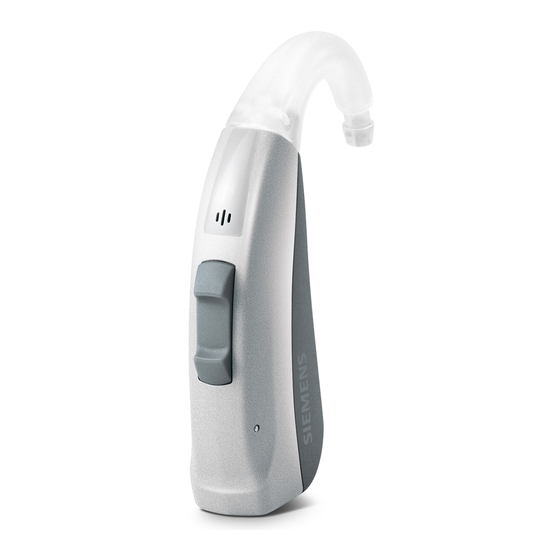
Summarization of Contents
Your Hearing Instruments: Overview and Components
Getting to Know Your Instruments
Familiarize yourself with your new hearing instruments and their controls for easier use.
Components and Names (Orion S/Sirion S)
Diagrams identifying the parts of Orion S and Sirion S hearing instruments.
Components and Names (Orion M/Sirion M)
Diagrams identifying the parts of Orion M and Sirion M hearing instruments.
Components and Names (Orion P/Sirion P)
Diagrams identifying the parts of Orion P and Sirion P hearing instruments.
Controls and Operation Basics
Overview of push buttons and rocker switches for volume and program adjustments.
Push Button Functions Explained
Details on push button functions: program change, volume, and power.
Rocker Switch Functions Explained
Details on rocker switch functions: program, volume, tinnitus, and standby.
Device Settings and Special Features
Information on hearing programs, power-on delay, e2e wireless, and telecoil features.
Battery Size and Ear Piece Selection
Details on battery types (size 13, 312) and available exchangeable ear pieces.
Service and Contact Information
Record serial numbers, service dates, and purchase date for your hearing instruments.
Batteries: Replacement and Handling
Replacing Batteries: Removal Procedure
Step-by-step guide for safely removing batteries from the hearing instrument.
Replacing Batteries: Insertion Procedure
Proper procedure for inserting new batteries, ensuring correct orientation and compartment closure.
Daily Use and Operation Guide
Turning Hearing Instruments On and Off
Learn the various methods for powering your hearing instruments on and off.
Understanding the Power-On Delay Feature
Understand the power-on delay for smooth insertion without whistling.
Inserting Hearing Instruments Correctly
Detailed instructions for correct and comfortable insertion into the ear canal.
Using the Optional Concha Lock
Guidance on positioning the optional concha lock for secure ear piece fit.
Removing Hearing Instruments Safely
Safe steps for removing hearing instruments, including a caution for potential risks.
Adjusting Volume Levels
How to manually adjust volume via controls or remote, noting Sirion S limitations.
Changing Hearing Programs
Switch hearing programs to optimize sound for different listening environments.
Optional Control Adjustments
Using controls for additional functions like tinnitus noiser level adjustment.
Locking and Unlocking Controls
Prevent accidental operation by learning to lock and unlock device controls.
Using Two Hearing Instruments Together
Benefits and methods for controlling two instruments simultaneously with e2e wireless.
Special Use Cases: Phone and Audio Connectivity
Phone Usage and Telephone Program
Optimizing phone calls with the dedicated telephone program.
Audio Induction Loops and Telecoil
Using telecoil programs in public spaces for enhanced audio reception.
Audio Input and FM Systems
Connecting to FM systems and audio devices via an audio shoe.
Audio Shoe Attachment and Removal
Procedure for attaching or removing the audio shoe, requiring professional assistance.
Maintenance and Care for Your Instruments
Daily Cleaning Procedures
Essential daily cleaning steps to maintain hearing instrument hygiene and function.
Cleaning the LifeTubes
Specific instructions for cleaning LifeTubes using a cleaning wire to remove debris.
Drying and Storage Guidelines
Proper methods for drying instruments overnight and storing them to prevent moisture.
Exchanging Tubes and Ear Pieces
Recommendation for periodic replacement of tubes and ear pieces for optimal performance.
Important Information
Intended Use and Professional Fitting
Defines the purpose of hearing instruments and the necessity of professional fitting.
Symbols and Icons Explained
Guides the user through the meaning of warning symbols and informational icons.
Transport and Storage Conditions
Specifies environmental conditions for safe transport and storage of the device.
Disposal and Recycling Information
Instructions for responsible disposal and recycling of the hearing instrument and its components.
Technical Specifications Overview
Provides key technical details, including FCC ID, IC, and operating frequencies.
Regulatory Compliance (FCC/Canada)
Details compliance with FCC and Canadian regulations for the device's operation.
Conformance and Certification Details
Confirms adherence to European Directives for medical devices and radio equipment.
Safety Information for Hearing Instruments
Personal Safety Precautions
Covers safety regarding ear piece attachment, electronic interference, and device handling.
Product Safety Guidelines
Protects the device from heat, moisture, radiation, and improper drying methods.
Tinnitus Noiser Safety Warnings
Addresses risks associated with tinnitus noiser use and the need for professional consultation.













Need help?
Do you have a question about the Sirion M and is the answer not in the manual?
Questions and answers